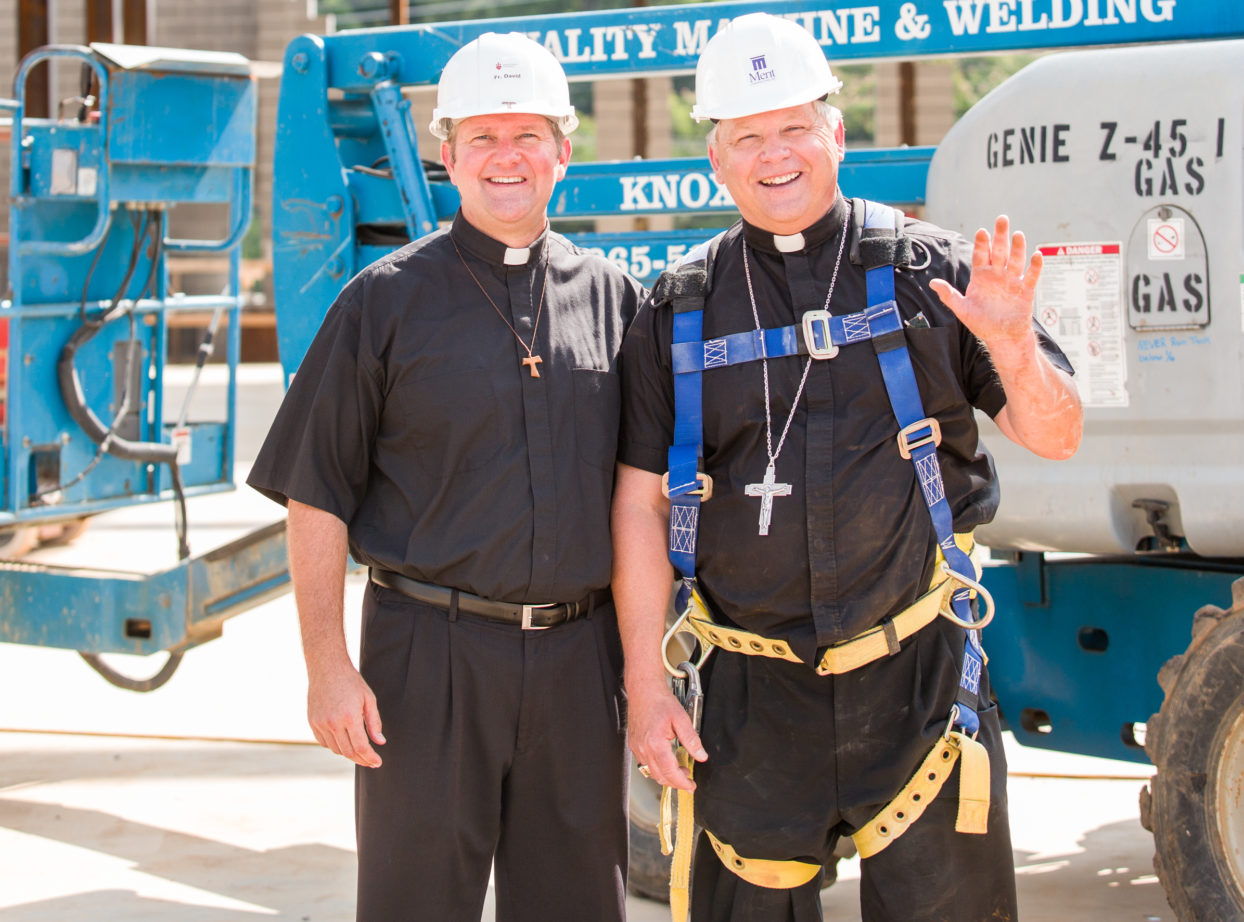Cathedral construction reaches its halfway point as Bishop Stika inscribes his motto in dome of our new mother church
By Bill Brewer
“Jesus, I trust in you.” These world were never more appropriate than when Bishop Richard F. Stika strapped on a safety harness, climbed into a mechanical boom lift, and was hoisted 14 stories above ground to inscribe “Iesu Confido in Te” on a steel beam forming the dome of the new Cathedral of the Sacred Heart of Jesus.
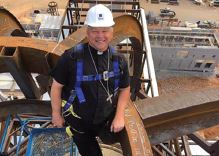 In placing his episcopal motto on the beam, Bishop Stika was writing for the Diocese of Knoxville, which has placed its full faith in the diocese’s new mother church being built next to the existing Sacred Heart Cathedral.
In placing his episcopal motto on the beam, Bishop Stika was writing for the Diocese of Knoxville, which has placed its full faith in the diocese’s new mother church being built next to the existing Sacred Heart Cathedral.
For John Nelson, the bishop’s words have special meaning. After all, it was Mr. Nelson who escorted Bishop Stika to the apex of the cathedral dome on July 14 so the inscription could be placed. Then it was Mr. Nelson, a steelworker for cathedral subcontractor Quality Machine and Welding Co. of Knoxville, who later ascended 140 feet back to the top of the dome, unbeknownst to anyone, and welded “Iesu Confido in Te” into the steel beam for permanence.
“He welded it just enough so that it wouldn’t throw the dome off. It’s not a thick weld, but it is up there forever. It was a nice touch. He didn’t have to do that,” Bishop Stika said of Mr. Nelson’s contribution to diocesan history.
It is just that attention to the project that has impressed Bishop Stika and Father David Boettner, rector of Sacred Heart Cathedral, who is managing the project for the diocese.
When asked what surprises them most about the project so far, the bishop and rector agree it is the interest, care, and attention to detail that construction workers show in erecting the cathedral.
Father Boettner said that as interest in the cathedral among the East Tennessee Catholic community builds, the workers also are excited and quite proud of the work they’re doing.
“This is their baby, too, and they definitely have a large investment and ownership in it,” he said. “I think that no matter what, at the end of the day, these guys are going to walk away knowing that these Catholics are serious about their relationship with the Lord.”
Bishop Stika and Father Boettner have developed a rapport with the workers, who are accustomed to Bishop Stika’s regular visits to the site as he mingles with them while inspecting the progress. As project manager, Father Boettner is regularly on site and leads construction team meetings most every week.
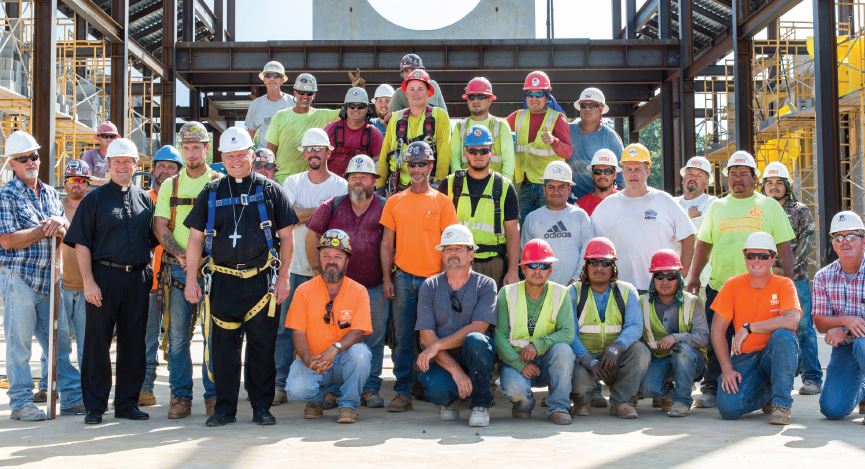 Father Boettner is impressed by how the construction crews and those with the diocese overseeing the project have meshed since ground was first broken in April 2015. He believes that synergy has made the project a success.
Father Boettner is impressed by how the construction crews and those with the diocese overseeing the project have meshed since ground was first broken in April 2015. He believes that synergy has made the project a success.
“We spend so much time with these workers every day that they’ve become like family. We know their stories. They know ours. They may never have ever encountered a Catholic prior to this job. And now they’ve had an experience of getting to know the Catholic Church, and we’ve gotten to know them. It has been a great chemistry,” he said.
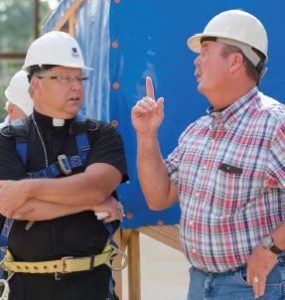 Site superintendent Fred Atkins believes the project has had an impact on the workers.
Site superintendent Fred Atkins believes the project has had an impact on the workers.
“When you come here, you feel this is for a greater purpose than just working here. And the men feel that. They like the project,” he said. Few are closer to the project than the one who forged idea into reality: Bishop Stika. The personal interest he has taken in the new cathedral borders on labor.
“I go there every night, not only to be nosy, but I pray for the workers. Sometimes I pray a rosary, sometimes I just pray for all those involved in the construction, as well as for all the donors and for the diocese,” Bishop Stika said. “I like to see the progress. And what’s exciting about it is it is starting to look like a church. I can see the dream of the people of God of the Catholic Church in East Tennessee is coming to fruition. There have been some naysayers, but they now are coming up to me and saying, ‘Now I understand. It’s no longer on paper. I can see it.’”
And for East Tennessee Catholics wondering how the cathedral is progressing, the bishop gives nearly daily progress reports on his Facebook page. And for those not on Facebook, Father Boettner makes sure updated video, photos, and information about the project are on the Sacred Heart website.
Bishop Stika often speaks with Mr. Atkins about the progress, but the bishop resists pinning down a project deadline. He remembers a scene in the classic film “The Agony and the Ecstasy,” where Pope Julius
II keeps asking Michelangelo when the Sistine Chapel paintings will be completed, prompting Michelangelo to respond, “When it is done, your Holiness, when it is done.”
“So I am very hesitant to ask for any deadlines,” the bishop said.
However, Mr. Atkins, who is with cathedral general contractor Merit Construction, reports that the project is on schedule and within budget as it hits the halfway point.
And Father Boettner adds that if all continues to go as planned, the new mother church for the diocese could be ready for Masses by late 2017, with an official dedication in early 2018 that would mark the 30th anniversary of the diocese’s founding. Bishop Stika is considering designating 2018 as a special holy year in the diocese. December 2017 is the date Mr. Atkins and his crews are working toward.
So far, the construction crews have been able to overcome any inclement weather and a couple of other delays to stay on schedule.
Bishop Stika is most impressed by the intricacy of the work, whether it’s the site excavation that elevated the ground 23 feet to the precise point where construction could begin, the drilling and placement of more than 100 piers into the soil to create a foundation, the pouring of more than 14,000 tons of concrete resulting in perfectly even surfaces, or the piecing together of scores of steel beams that connect flawlessly to give the cathedral its shape.
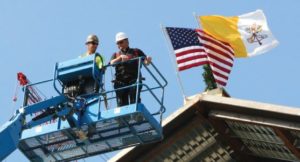 The bishop had a bird’s-eye view of the cathedral dome not long after workers had navigated arched beams into place. After writing his episcopal motto, “Jesus, I trust in you,” with chalk in Latin, he could see just how high the dome reaches against the West Knoxville skyline.
The bishop had a bird’s-eye view of the cathedral dome not long after workers had navigated arched beams into place. After writing his episcopal motto, “Jesus, I trust in you,” with chalk in Latin, he could see just how high the dome reaches against the West Knoxville skyline.
Now that the dome, with cupola and cross, has pierced that skyline, the cathedral is more noticeable to the community and is even visible from Interstate 40/75.
That is exactly how it was planned, according to Father Boettner.
“When we first envisioned a cathedral for the diocese, we went back and forth, not just on a design, but how we want the cathedral to reach people. You want the cathedral to reach people before they reach the cathedral. You want it to be reaching out to them, to invite them to come take a look, because there is something important here,” the diocesan priest said.
“The dome is obviously a beautiful architectural feature, and it also connects us to the universality of the Church because of the dome over the Basilica of St. Peter, which is over the tomb of Peter. That centrality of the Church united together with Peter and all those who sit in the chair of Peter, the popes, helps to connect us to that universal mission of the Catholic Church, the mission of Jesus Christ,” he added. “So, as you’re driving up, you instantly notice the dome. That, from the very beginning, is unique. It also starts to interact with people as they approach.”
Staying true to the connection with the early Church, Father Boettner keeps on his desk a piece of bedrock excavated from one of the pier holes. Noting that the new Sacred Heart Cathedral is built firmly on bedrock, he’s quick to note the parallel with Scripture, when the Lord said to Peter, “Upon this rock, I will build my Church.”
“Our church is literally built on rock. Each pier is resting on bedrock,” said the cathedral rector, who also serves as a vicar general and moderator of the curia for the diocese.
Even as he has closely watched every construction phase so far, Father Boettner still expresses amazement at how a cathedral is emerging from that foundation.
And he realizes the project also is an evangelization tool.
“I’m pleased that as the church is coming together, all of these elements are coming into reality, and we’re seeing how, even in a skeletal form, some of those elements already are accomplishing what we hoped for — that they’re reaching out to people and inviting them to come closer and maybe even ask questions,” he said.
Just outside of Father Boettner’s office, one of only two new Catholic cathedrals being built in the United
States is looming larger and larger. But amid all the construction activity that represents the largest project ever undertaken in the Diocese of Knoxville, Father Boettner has to prioritize matters of God, whether it’s the tons of steel being set in place to form the new cathedral’s “bones,” weddings, funerals, and regular Masses in the present cathedral, or any of a multitude of issues he must deal with as a parish pastor on a daily basis.
 And then there is Sacred Heart Cathedral School, which carries out its daily mission amid all the construction. The school’s some 700 faculty, staff, and students don’t just tolerate the construction hubbub — they embrace it.
And then there is Sacred Heart Cathedral School, which carries out its daily mission amid all the construction. The school’s some 700 faculty, staff, and students don’t just tolerate the construction hubbub — they embrace it.
Father Boettner, Sacred Heart School Principal Dan Breen, and Mr. Atkins are making the project a learning opportunity for students and faculty. Each class has studied specific aspects of the new cathedral as it goes up. And Mr. Atkins, with some of his workers, has visited the classrooms to talk with students. He is the one person intimately familiar with each aspect of construction.
“I tell my subcontractors that this is like an orchestra. I don’t need to know how to play every instrument; I just need to know when every instrument needs to be played,” the project’s site superintendent said.
Father Boettner described the project as a learning laboratory just outside the classroom windows. It’s been an education for him, too.
When asked if the scope of the project was what he expected,
Father Boettner said, smiling, “God is good to children and fools. I don’t know if I could have imagined the scale of it when Bishop Stika first said it’s time for us to consider building a cathedral.
But as we got into the design process, I quickly began to realize how big this project is.
“Clearly this is the biggest project I’ve ever worked on and, hopefully, the biggest thing I’ll ever work on,” he added, laughing. “It’s a once-in-a-lifetime project for a diocese.
Obviously for me, it’s a great honor to be a part of it. We have an amazing team of people working on it. I’ve been blessed as a priest my whole life with always being surrounded by great mentors and people I can learn from. One of the greatest joys I’ve had with this project is every day I get to learn something new. And there is always something more that I can learn.”
Father Boettner points out that liturgy is being built into the church, from the religious and artistic treatments to the walls, which were designed to benefit the music that will fill the cathedral.
“I’ve never built anything that was designed to last for hundreds of years. But I’ve had the opportunity to learn a lot more about marble, the various kinds of marble, how to shape the marble to create beautiful designs, both for the flooring and altars. I’ve learned a tremendous amount about acoustics,” he said. “We’ve spent a great deal of time and energy on the acoustics of this building so that it will have excellent acoustics. We’ve used computer analysis so that we can identify clearly what areas needed to have acoustical plaster and what areas would use drywall. So we’ve shaped and honed the sound of the building itself. Before you ever put any sound amplification in the building, we already know what kind of sound to expect in the building itself.”
He also has been getting an education in religious iconography, understanding the history behind the devotion to the Sacred Heart of Jesus, the various saints associated with the devotion of the Sacred Heart, and the religious imagery that goes along with the Sacred Heart of Jesus, as well as all the stories of Scripture that speak of the heart of Jesus.
“Literally, this whole project has been about preaching, because a cathedral is theology in stone, and so you want the building to preach even when no one is talking,” Father Boettner said.
The building already is doing that. The Sacred Heart rector calls it grass-roots evangelization.
At the halfway point of construction, the next steps are completion of the steel work, then finishing the exterior before moving inside.
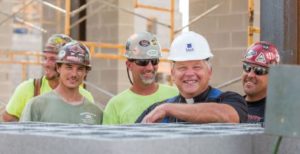 Steelworkers are finishing erecting the beams, mechanical workers are installing the heating, air-conditioning, and ventilation infrastructure, and masons are placing the block walls before doing stone and brick work. The last pieces of steel erected were for the cupola on top of the dome. The cupola has a cross mounted atop it.
Steelworkers are finishing erecting the beams, mechanical workers are installing the heating, air-conditioning, and ventilation infrastructure, and masons are placing the block walls before doing stone and brick work. The last pieces of steel erected were for the cupola on top of the dome. The cupola has a cross mounted atop it.
Window frames and door frames will arrive in November.
The HVAC system should be operational in February, which means the building will be tight, with windows and doors installed and exterior stone and brick in place, according to Father Boettner.
“The next step really is to put the skin on. We’ve got the bones, and now we’re putting the skin on.
Then we will come inside and start fleshing out the inside,” he said, noting that will entail putting in the electrical and mechanical systems, the drywall, acoustical plaster, paint treatments, religious and artistic items such as the pulpit, marble flooring, altars, tabernacle, baldacchino, pews, and bishop’s chair, and finished-trim woodwork.
The cathedral is on schedule to be under roof and in the dry by early 2017.
The woodwork, much of which will be done by local wood artisan Clancy Custom Woodworking, will include a frieze that will be a horizontal banding just below the clerestory windows that will have inscribed in it the litany of the Sacred Heart of Jesus all the way around the interior.
The new cathedral will be three times larger than the present one, which opened in 1956, and can accommodate a rapidly growing diocese.
Father Boettner and Bishop Stika praise all those involved in the project, including donors from within the parish, from the diocese, and from outside the diocese, who have generously given to make the cathedral a reality.
“I have been asking [for donations] for the future of this diocese. And the cardinal [Justin Rigali] has been excellent. He is working with people outside the diocese. We are a great team. That’s why I believe if not now, never, because of his contacts outside the diocese, as well as mine, and the generosity of all the people in the diocese. It’s the perfect storm in a good way, the perfect rainbow,” said Bishop Stika, who has pledged his largest donation ever to the cathedral project.
Bishop Stika and Father Boettner feel their presence in the diocese at this point in history is providential.
“I appreciate the fact that I am able to witness this, to be a part of this real historic moment in the life of the diocese,” the bishop said. “When it’s complete and we’re praising God in the Eucharist, people are going to say this is something of noble simplicity. It’s not extravagant. We’re also not building something that is going to be around for only a short time. We’re building for the ages. That is very gratifying, too.”
For Catholics and non-Catholics alike, the new Cathedral of the Sacred Heart of Jesus is a testament to the trust East Tennesseans have in Jesus Christ.
“I would love for everybody to be able to be as familiar with this project as I am, and be able to enjoy what is going on here. People see the mud and dust and the steel, but what I hope we’ve been able to communicate is the excitement and the faith that is being built here,” Father Boettner said. “This project has never been about building a building. It’s been about building faith. We need to continue that focus on building faith, and helping people to see that this structure is a place where they have a home.”

